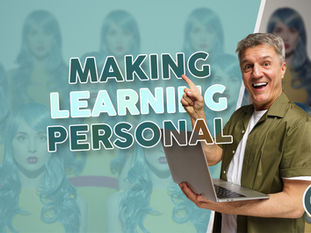
THE NEXT TOP (LEARNING) MODEL: EMBODIED COGNITION
1
5
0
Want Smarter Learners? Get Them Moving. The Case for Embodied Cognition.
Imagine learning to tie your shoelaces just by reading about it. Or trying to master driving through a slide deck.
Some things you just have to do to understand.

That’s the idea behind Embodied Cognition. It’s a learning theory that argues our brains don’t learn in isolation. They learn with our bodies. Through movement. Through touch. Through experience.
It’s a concept that’s as old as human learning itself, but now, backed by neuroscience, it’s reshaping how we design effective, memorable learning experiences.
What Is Embodied Cognition?
Embodied Cognition is the idea that cognitive processes such as thinking, understanding, and remembering, are deeply linked to our physical bodies and how we interact with the world around us.
In other words: your brain doesn’t do all the learning on its own. Your hands, posture, gestures, even how you move through space all play a part.
The theory gained traction in the late 1990s and early 2000s, thanks to researchers like George Lakoff and Mark Johnson, who showed that abstract thought is often grounded in physical experience. Think: “grasping an idea” or “feeling the weight of a decision.”
In learning, this translates to the simple truth that we remember better when we engage more of ourselves in the process.
Why It Matters in Learning and Development
Most workplace training still leans heavily on screens, slides and PDFs. But if we ignore the body, we miss a huge opportunity to deepen learning.
Here’s how embracing Embodied Cognition can benefit your organisation:
Better retention – Physical involvement helps commit information to long-term memory.
Stronger skills transfer – Doing supports deeper understanding and builds confidence.
Improved communication – Gestures and expression help learners explain and absorb ideas.
More inclusive learning – Movement and sensory engagement help neurodiverse learners thrive.
Higher engagement – Active participation beats passive watching, every time.
In short: if you want learning that sticks, you need to get learners doing, as well as reading or watching.
How to Apply Embodied Cognition in Digital Learning
“But we’re not in a classroom,” you might say. “How can I get learners moving through a screen?”
Great question. The truth is, you don’t need a yoga mat or a dance routine to bring embodied learning into digital spaces. Try these strategies:
Use simulations and scenario-based learning
Let learners make decisions, explore environments, and move through digital spaces.
Include interactive narration or gesture-based cues
Prompt learners to say, gesture, or visualise responses - engaging motor memory.
Encourage physical note-taking or sketching
Simple, off-screen actions reinforce concepts more deeply than on-screen clicking alone.
Design mobile learning that invites real-world action
Ask learners to observe, record or practice something in their actual environment.
Blend digital with in-person learning
Use eLearning as a launchpad for physical practice in team sessions or on-the-job tasks.
How Popcorn Designs Learning That Moves People
At Popcorn Learning Agency, we know that passive learning = forgettable learning. That’s why we use principles from Embodied Cognition to design content that goes beyond the screen.
Filmed scenarios that show, not tell, prompting reflection and mirrored behaviour.
Interactive eLearning with real-world prompts and motor engagement.
Practical toolkits that learners physically use alongside digital learning.
Impact evaluations that track not just knowledge, but behaviour change.
Whether we’re building custom eLearning content, mobile learning solutions, or blended learning strategies, our goal is the same: make the learning real. Make it physical. Make it stick.
Final Thoughts: Don’t Just Train Minds. Engage Bodies.
Embodied Cognition reminds us that we’re not just heads on Zoom calls. And if we want to create learning that truly transforms performance, we need to tap into more than just cognition. We need to tap into sensation. Motion. Experience.
Because when learning moves you – literally - it’s far more likely to last.
Want to build learning that engages the whole person? Popcorn can help you design experiences that inform, involve and inspire. Follow us on LinkedIn for more from Popcorn’s Next Top (Learning) Model.






